Maybe this will help you out.IF you don't understand the basics then all you can do is put blind faith that what some one else has said is factually correct .
As you are totally unwilling to put in the work to educate yourself then you will never actually understand how lubrication works.
I started my learning curve back in 1972 in the final years of my degree with a 2 hour lecture once a week for 13 weeks.
So that is 26 hours of face to face lectures + 13 more of tutorials + 13 more of practicals + 51 of pre lecture back ground reading before lectures.
How many hours have you spent on face book ?
As for mower engine as was previously stated is all using a synthetic or semi synthetic will do is cost you more money .
But if it makes you feel good then do it all it will do is waste your money .
While their history goes back decades fully synthetic oils were developed commercially for F1 racing where spending $ 1000 / gallon on oil is petty cash.
The engines in F 1 are pushed to their max they run at a lot higher temperatures than you mower ever will and every part has been cut down to the absolute minimum weight that will hopefully stay together for the length of a race and the manufacturing tollerances are substantially tighter than your mower ever will plus the oil plays a massive part in cooling the engine , or rather keeping the internals at a constant temperature , again totally irrelevent to an ir cooled mower engine and requires a bit of maths .
Viscious friction robs power from the tailshaft so anything that can reduce it is a big + in racing.
When we raced speedway all of the engines run total loss oiling and you do notice the difference in responce between that and the same engine mounted into a Hagon frame with an oil tank for short circuit
Synthetic oils they stayed as an exotic item even during the oil crisis of the 70's when I was in college . untill California tightened emission laws then all the major engine makers found that the thinner oils allowed the engine to crank faster so the first cylinder to do a full induction cycle fired reducing the unburned fuel passed out the tail pipe thus meet the starting emissions tests for almost no developement costs.
The engines were run to destruction & oil galleries modified where necessary.
The oil companies were then told we want engine oils with these properties of the fully synthetic oils for our production engines but we will only pay $X / gallon for them .
Thus the semi-synthetic ( and that name is total BS as the oil is not synthetic & never was ) oil was born by stripping the dreaded "Dino oil" into some componant parts then recombining them in proportions that would not normally happen and that is part & parcel of the normal processing of normal oils .
All that the oil companies did was add a couple of extra distillation processes to the regular processing .
True synthetic oil, created by reacting gasses together under pressure is a different animal but you won't find it at your local discount car parts shop.
The oil companies then had a premium product that cost marginally more than the standard product but because of the hype around it could be sold for 3 times the price of regular oil and pushed it hard by extolling its better properties, most of which was almost true but none of it of any real benefit for any engine not specifically designed to run it .
So you can run it for 3 times as long as you can run standard oil before it oxadises and starts to brake down chemically.
But that is not why you change your oil
You change it to remove the acid byproducts of combustion which happen regardless of the oil used and more importantly to remove the ultra fine particulates that errode your engine the exact same was as the Colorado river has erroded the Grand Canyon , but they fail to tell you that.
As for mower engine what can I say?
Probably once or twice a year an old worn out 2.5Hp side valve B & S powered mower comes into the shop with about 1/3 of the original oil still in the crankcase burned to the consistency of triple cream on a mower that the owner has had since the 80's and never so much as checked to oil let alone change it or even top it up.
And I would imagine every tech on here would have the same thing happen to them every year
Your 1981 B & S engine will run happily of full splash lubrication and there is a good chance it was actually full splash .
So your use of it just goes to show your absolute failure of understanding of the fundamentials of lubrication inside an engine.
The tug-o-war between adheason, coheasion & gravity let alone the significance of valence inbalance at the terminals of the molecules, and the difference the shape of them makes to the flow of the oil through the galleries.
And FWIW the only calculations in OLDS are just barely high school level and mainly about temperature flow & heat removal .
Get yourself a copy & read it then if you have understood what was written you will have just enough information to work out weather you are being fed fact, fiction or hype.
As an old text book it is probably everywhere used for $ 5 rather than the $ 50 I had to pay when it was a brand new publication.
Over the years I have found oil to be like religion and those who most strongly argue about it do so from a position of blind faith.
On one of the motorcycle forums we ran a survey to see just how much the members understood about oil
The question was
Do multigrade oils get thicker as they get hotter. yes / no
Over 90% got it wrong .
In my TAFE classe I used to ask the question
What is the purpose of the detergent molecules in oil ?
In the 11 years I taught not s single student got the question correct
We put the same question in the final exam and agin just about every student got it wrong
They all correctly described the mechanism of how they work but the students could not get the "detergents clean" BS out of their heads that the advertising companies had implanted .
And if you are wondering.
The function of the detergent is to carry away the particulates that they encounter & prevent them from combining
Secondary purpose is to make the contaminants close to the SG of the base oil so they will circulate freely within the oil to facilitate mechanical removal .
You will find that in OLDS as well no maths required .
You are using an out of date browser. It may not display this or other websites correctly.
You should upgrade or use an alternative browser.
You should upgrade or use an alternative browser.
Standard vs Synthetic Oil in differential
- Thread starter DB14867
- Start date
More options
Export threadOil seems to be a hotly contested subject any time a gasoline powered engine is talked about. In the attached video,
Is synthetic better? The attached video will clear up any doubt.
Ryan Stark of world-famous Blackstone Labs discusses the subject from an experienced laboratory viewpoint. Probably the best testimony available taken directly from years of actual testing. Is synthetic better? The attached video will clear up any doubt.
bertsmobile1
Lawn Royalty
- Joined
- Nov 29, 2014
- Threads
- 65
- Messages
- 24,995
I definately do not need Bob's blogs to reinforce what I have learned from professionals , physicists , chemist , molecular engineers and taught to students , I know and if pushed could probably do some of the calculations although it has been a long time but the old texts & notes are downstairs some where .Maybe this will help you out.
In my undergraduate years I worked at the Defence Standards Lab , the people who invented X-Ray diffraction analysis of oil so you know not only what metals are in the oil, but where that metal came from so we could tell if iron for example was from a lash cap, valve stem, piston ring , cylinder sleeve , crankshaft , cam shaft , valve train gear, timing gear or any where else if we knew the actual alloys used to make the part from.
That got plotted against actual measured wear and over time it was found that you could determine engine wear from the metals in the oil thus in place of strip down & measure on aircraft engines on a hours of use basis the engine can stay untouched for a lot longer till you detect significant wear in a critical part.
This is one reason why Australia ran their helicopters for far longer than any other military service till the analysis became SOP for military equipment as $ 3000 pop is a bit much for a car owner to pay.
Dissassembling & reassembling the engines does more damage long term than using the engine .
The AA Cromotography that the interviewee was talking about is the cheap & nasty production line method because it really does not tell you what is wearing and by how much.
OTOH if you do it regularly then again sudden increases in a particular metal signifies that some thing has started to fall apart and needs to be investigated. And it should be done almost every engine change and plotted against mileage .
Way beyond the perview of mower engines
However what was originally being argued was using different oil in hydros.
The best example I can think of is the BSA B25 & B50 engines of 1970-1973.
The B 25 has a plain white metal big end so needs a lot of oil at reasonably high pressure to float the big end
The B50 has needle roller big end bearing and could just about run on crankcase fume
The B25 has a high pressure high volume oil pump
The B50 has a low volume oil pump
Racers originally fitted the B25 pump to the B50's thinking that more oil would be a benefit but what actually happened was a failures of the big end due to the roller s sliding rather than rolling
Oil passages in engines are carefully sized to get the right amount of oil at the right pressure to the place to do the required job.
Now some times it is not critical while others it is
Synthetics is early hydro drive shorten their operation life drastically
Synthetics in late models is fine and for most now days it makes little difference because they are designed that way
If you care to read it, I posted some of your fiction material about this topic and got some good commentary on many of the specific things that you said, which are 100% not true and won't be found anywhere on any kind of legit research papers.I definately do not need Bob's blogs to reinforce what I have learned from professionals , physicists , chemist , molecular engineers and taught to students , I know and if pushed could probably do some of the calculations although it has been a long time but the old texts & notes are downstairs some where .
In my undergraduate years I worked at the Defence Standards Lab , the people who invented X-Ray diffraction analysis of oil so you know not only what metals are in the oil, but where that metal came from so we could tell if iron for example was from a lash cap, valve stem, piston ring , cylinder sleeve , crankshaft , cam shaft , valve train gear, timing gear or any where else if we knew the actual alloys used to make the part from.
That got plotted against actual measured wear and over time it was found that you could determine engine wear from the metals in the oil thus in place of strip down & measure on aircraft engines on a hours of use basis the engine can stay untouched for a lot longer till you detect significant wear in a critical part.
This is one reason why Australia ran their helicopters for far longer than any other military service till the analysis became SOP for military equipment as $ 3000 pop is a bit much for a car owner to pay.
Dissassembling & reassembling the engines does more damage long term than using the engine .
The AA Cromotography that the interviewee was talking about is the cheap & nasty production line method because it really does not tell you what is wearing and by how much.
OTOH if you do it regularly then again sudden increases in a particular metal signifies that some thing has started to fall apart and needs to be investigated. And it should be done almost every engine change and plotted against mileage .
Way beyond the perview of mower engines
However what was originally being argued was using different oil in hydros.
The best example I can think of is the BSA B25 & B50 engines of 1970-1973.
The B 25 has a plain white metal big end so needs a lot of oil at reasonably high pressure to float the big end
The B50 has needle roller big end bearing and could just about run on crankcase fume
The B25 has a high pressure high volume oil pump
The B50 has a low volume oil pump
Racers originally fitted the B25 pump to the B50's thinking that more oil would be a benefit but what actually happened was a failures of the big end due to the roller s sliding rather than rolling
Oil passages in engines are carefully sized to get the right amount of oil at the right pressure to the place to do the required job.
Now some times it is not critical while others it is
Synthetics is early hydro drive shorten their operation life drastically
Synthetics in late models is fine and for most now days it makes little difference because they are designed that way
Attachments
-
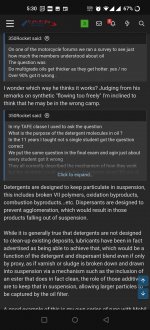 Screenshot_20211029-173009.jpg685.6 KB · Views: 10
Screenshot_20211029-173009.jpg685.6 KB · Views: 10 -
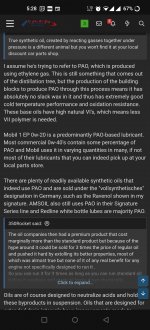 Screenshot_20211029-172818.jpg742.6 KB · Views: 11
Screenshot_20211029-172818.jpg742.6 KB · Views: 11 -
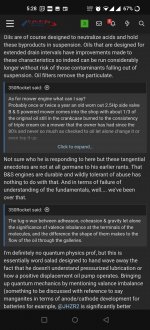 Screenshot_20211029-172841.jpg734.6 KB · Views: 9
Screenshot_20211029-172841.jpg734.6 KB · Views: 9 -
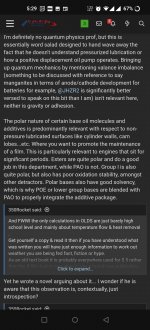 Screenshot_20211029-172929.jpg742 KB · Views: 8
Screenshot_20211029-172929.jpg742 KB · Views: 8 -
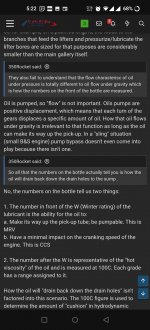 Screenshot_20211029-172242.jpg641.5 KB · Views: 6
Screenshot_20211029-172242.jpg641.5 KB · Views: 6 -
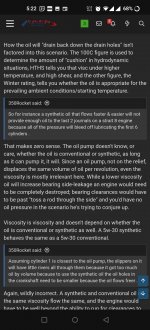 Screenshot_20211029-172251.jpg726 KB · Views: 6
Screenshot_20211029-172251.jpg726 KB · Views: 6 -
 Screenshot_20211029-172657.jpg636.1 KB · Views: 7
Screenshot_20211029-172657.jpg636.1 KB · Views: 7 -
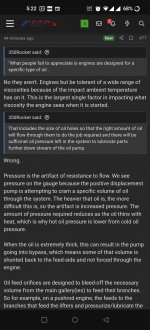 Screenshot_20211029-172236.jpg619.5 KB · Views: 4
Screenshot_20211029-172236.jpg619.5 KB · Views: 4 -
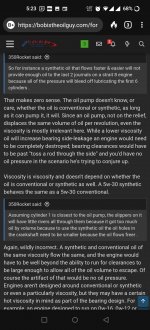 Screenshot_20211029-172321.jpg738.5 KB · Views: 5
Screenshot_20211029-172321.jpg738.5 KB · Views: 5 -
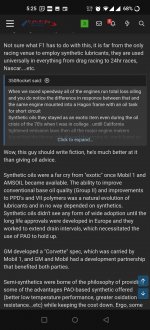 Screenshot_20211029-172553.jpg702.9 KB · Views: 11
Screenshot_20211029-172553.jpg702.9 KB · Views: 11
Btw, it is scary that you taught anybody on this subject.I definately do not need Bob's blogs to reinforce what I have learned from professionals , physicists , chemist , molecular engineers and taught to students , I know and if pushed could probably do some of the calculations although it has been a long time but the old texts & notes are downstairs some where .
In my undergraduate years I worked at the Defence Standards Lab , the people who invented X-Ray diffraction analysis of oil so you know not only what metals are in the oil, but where that metal came from so we could tell if iron for example was from a lash cap, valve stem, piston ring , cylinder sleeve , crankshaft , cam shaft , valve train gear, timing gear or any where else if we knew the actual alloys used to make the part from.
That got plotted against actual measured wear and over time it was found that you could determine engine wear from the metals in the oil thus in place of strip down & measure on aircraft engines on a hours of use basis the engine can stay untouched for a lot longer till you detect significant wear in a critical part.
This is one reason why Australia ran their helicopters for far longer than any other military service till the analysis became SOP for military equipment as $ 3000 pop is a bit much for a car owner to pay.
Dissassembling & reassembling the engines does more damage long term than using the engine .
The AA Cromotography that the interviewee was talking about is the cheap & nasty production line method because it really does not tell you what is wearing and by how much.
OTOH if you do it regularly then again sudden increases in a particular metal signifies that some thing has started to fall apart and needs to be investigated. And it should be done almost every engine change and plotted against mileage .
Way beyond the perview of mower engines
However what was originally being argued was using different oil in hydros.
The best example I can think of is the BSA B25 & B50 engines of 1970-1973.
The B 25 has a plain white metal big end so needs a lot of oil at reasonably high pressure to float the big end
The B50 has needle roller big end bearing and could just about run on crankcase fume
The B25 has a high pressure high volume oil pump
The B50 has a low volume oil pump
Racers originally fitted the B25 pump to the B50's thinking that more oil would be a benefit but what actually happened was a failures of the big end due to the roller s sliding rather than rolling
Oil passages in engines are carefully sized to get the right amount of oil at the right pressure to the place to do the required job.
Now some times it is not critical while others it is
Synthetics is early hydro drive shorten their operation life drastically
Synthetics in late models is fine and for most now days it makes little difference because they are designed that way
bertsmobile1
Lawn Royalty
- Joined
- Nov 29, 2014
- Threads
- 65
- Messages
- 24,995
All you are proving Rocket is that your understanding of the physics & chemistry of oil is not as good as you think it isBtw, it is scary that you taught anybody on this subject.
Multi grades get thinner as they get hot
I said that and your GURU said that
it is just multigrades thin at a slower rate so an oil that was 10 at room temp is equivalent to one that was 30 at room temp when they are both at operating temperature
Detergents carry away what surficants & solvent dislodge
Dispersants cause the detergent wrapped particulate to do what their name suggest disperse and not agglomerate ( detergents do the same things but to a lesser degree )
An oil that is labeled ad "detergent" may or may not also have surficants & solvents in it
Flow charasteritisc are determined by the same factors regardless of weather the force creating the flow is gravity or a pump all that changes is the pressure
With all things being equal the volume of oil that can pass through a specific hole will be greater for synthetics because of their reduced internal friction
Thus at each and every bleed off point more synthetic oil will flow through the holes and into the sump than a conventional oil will
SO an engine designed to run synthetic oils will usually have smaller holes
The crunch comes where there is just not enough oil at sufficient pressure at then end of the line to maintain a complete film .
It is not really rocket science.
Now to get back to the actual question which was about hydro transmissions
synthetics will flow at a higher rate through the gap between the valve chest and the valve plate as there is NO SEAL so the system is relying on the resistance of the oil escaping between the two surfaces being higher than the resistance of the motor pistons , which is why they have to run a full speed all the time
To control this the surfaces of the valve chest & valve plate are machined to a specific surface roughness to create a high resistance turbulent flow situation when used with an oil of specific flow rate ( or slower )
Synthetics are specifically to flow fast so when used in hydros designed to run on standard oils will fail prematurely.
I did try to work out what you were saying in those screen shots but they were very difficult to follow as to what was you & what was me which makes it too hard to follow your lines of arguement.
FWIW I was trained in applied sciences so I am always more than happy top be proven wrong so I can update to the latest most correct information
Our understanding of things is always getting deeper & deeper but the opperative word is proven.
I have spent too mush time calculating flow rates through pipes ( furnace flues and metal through moulds mostly ) to accept things that counteract what I know is applicable .
I do conceede that some of my wording could have been better but I was not trying to write another Phd thesis with footnotes & annotations, just some thing that most could be able to visualize without going back & doing 20 rewrites and full of jargon to make me sound smart that many will not understand thus find confusing .
Last edited:
I'm done reading your posts to their complete entirety because they are full of so much crazy info (especially about the oil holes being smaller for synthetic lol) viscosity is viscosity no matter what the base is. But I agree we got off topic. But the short of it is you clearly have no idea about viscosity and synthetics. In your own mind you and a couple other people (know idea where you found them) are the only experts on the subject. If you can't dazzle them with brilliance, baffle them with bs. I will not be back to this thread, it's honestly painful and just makes me mad. I hope others picked up ok the falseness of enough of your statements that they can come to their own conclusions.All you are proving Rocket is that your understanding of the physics & chemistry of oil is not as good as you think it is
Multi grades get thinner as they get hot
I said that and your GURU said that
it is just multigrades thin at a slower rate so an oil that was 10 at room temp is equivalent to one that was 30 at room temp when they are both at operating temperature
Detergents carry away what surficants & solvent dislodge
Dispersants cause the detergent wrapped particulate to do what their name suggest disperse and not agglomerate ( detergents do the same things but to a lesser degree )
An oil that is labeled ad "detergent" may or may not also have surficants & solvents in it
Flow charasteritisc are determined by the same factors regardless of weather the force creating the flow is gravity or a pump all that changes is the pressure
With all things being equal the volume of oil that can pass through a specific hole will be greater for synthetics because of their reduced internal friction
Thus at each and every bleed off point more synthetic oil will flow through the holes and into the sump than a conventional oil will
SO an engine designed to run synthetic oils will usually have smaller holes
The crunch comes where there is just not enough oil at sufficient pressure at then end of the line to maintain a complete film .
It is not really rocket science.
Now to get back to the actual question which was about hydro transmissions
synthetics will flow at a higher rate through the gap between the valve chest and the valve plate as there is NO SEAL so the system is relying on the resistance of the oil escaping between the two surfaces being higher than the resistance of the motor pistons , which is why they have to run a full speed all the time
To control this the surfaces of the valve chest & valve plate are machined to a specific surface roughness to create a high resistance turbulent flow situation when used with an oil of specific flow rate ( or slower )
Synthetics are specifically to flow fast so when used in hydros designed to run on standard oils will fail prematurely.
I did try to work out what you were saying in those screen shots but they were very difficult to follow as to what was you & what was me which makes it too hard to follow your lines of arguement.
FWIW I was trained in applied sciences so I am always more than happy top be proven wrong so I can update to the latest most correct information
Our understanding of things is always getting deeper & deeper but the opperative word is proven.
I have spent too mush time calculating flow rates through pipes ( furnace flues and metal through moulds mostly ) to accept things that counteract what I know is applicable .
I do conceede that some of my wording could have been better but I was not trying to write another Phd thesis with footnotes & annotations, just some thing that most could be able to visualize without going back & doing 20 rewrites and full of jargon to make me sound smart that many will not understand thus find confusing .
- Joined
- Sep 24, 2017
- Threads
- 288
- Messages
- 6,890
Back to topic please.
My last statement I meant to make is that if your hydro calls for 20w50 engine oil (like mine does) you can use synthetic 15w50. The shop I've been going to only seems to carry Mobil 1 15w50 for this application.
Synthetic does not flow faster except when cold (as when cold all oils are way too thick and yet they still function down to a certain temperature). Pour point will be lower on synthetic. The very basic point is that you can have less wear during warm up if you use synthetic.
Whether or not you will notice the difference or it's worth it, is up for debate, but the facts are available so you can make whatever choice you want.
Synthetic does not flow faster except when cold (as when cold all oils are way too thick and yet they still function down to a certain temperature). Pour point will be lower on synthetic. The very basic point is that you can have less wear during warm up if you use synthetic.
Whether or not you will notice the difference or it's worth it, is up for debate, but the facts are available so you can make whatever choice you want.
That is rubber hose bits flaking off getting into the oil. If heat was to do as you describe, that oil would be over 400F+. Which is hotter than any oil can stand and not deteriorate.I use Mobil 1 Synthetic 15W-50 as called for in the manual. Those Hydro's do run very hot and I was surprised to see it gets so hot that it turns the Mobil 1 black from the heat!
.
.
.
